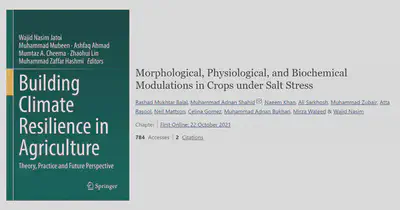Abstract
Crop plants are affected by biotic and abiotic stresses (including salinity) and such stresses may affect the growth and yield of these crop plants seriously. High temperature (due to climate change) has also changed the pattern of precipitation and caused rise in sea level. These two factors have impacted soil salinization. To address such problems naturally, the crop plants adapt themselves by different mechanisms including changes in morphological, physiological, and biochemical processes. Both ions including sodium and chloride are the main ions, that become the reason for many physio-biochemical modulations inside plant tissues, in a similar way, chloride ion is the most dangerous because NaCl releases around 60% more ions in soil comparatively with Na2SO4. An extra amount of such types of salts increases the osmotic potential in soil matrix consequently the water absorbance by plants is reduced that leads towards physiological stresses or drought. This increase of Cl− relates to salt tolerance that is linked to plant growth, water use efficiency, and transpiration. Increasing salinity in the nutrient solution reduces growth directly and restricts leaf and root mineral fixing. In this chapter, we have discussed insights into various kinds of morphological, physiological, anatomical, and biochemical modulations in plants caused by abiotic stresses especially salinity. In the era of climate change, plant scientists should focus on each shotgun approaches as well as long-term genomic techniques to enhance salt tolerance in commercially important crops to ensure food security and sustainable productivity.
